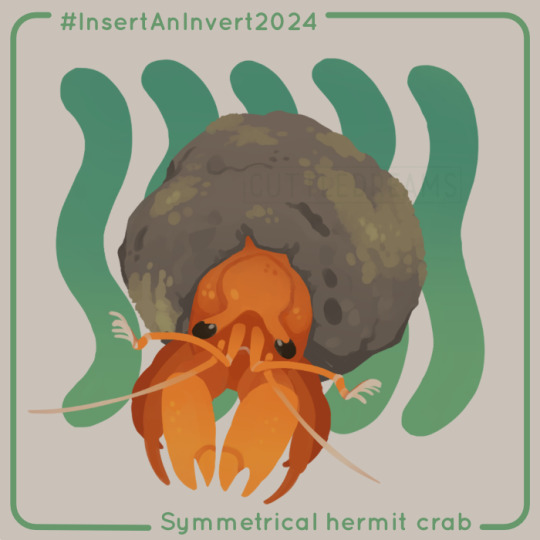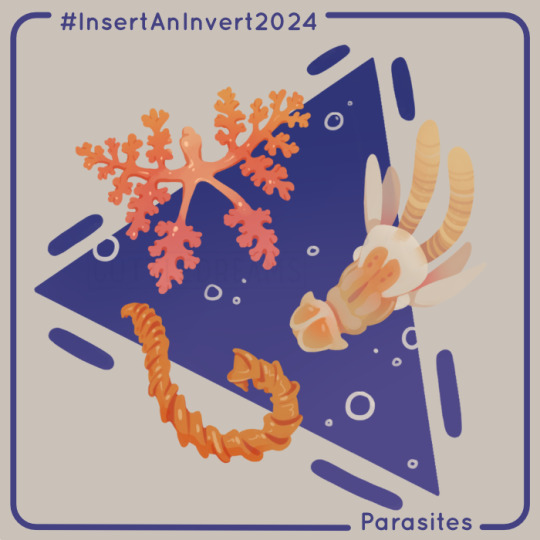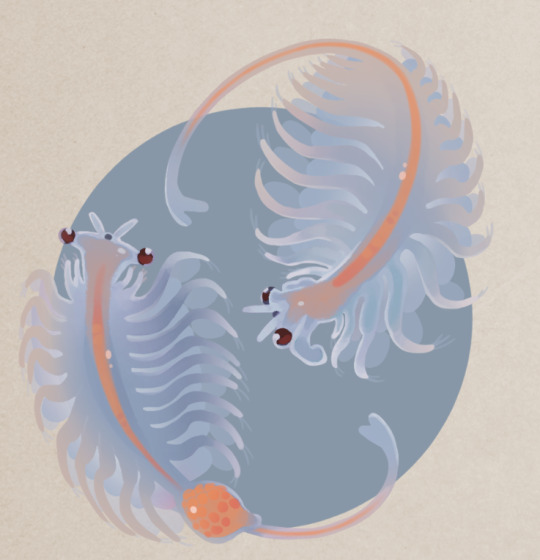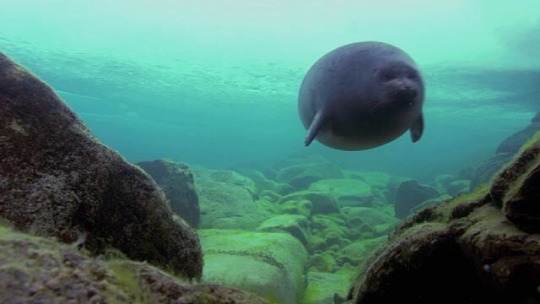#Lake Baikal Amphipod
Explore tagged Tumblr posts
Text




We finally rollin, let the catch-up begin
May: Carcinization
1: True Crab: Lollipop Crab (Ixa cylindrus)
2: False Crab: Symmetrical Hermit Crab (Pylocheles mortensenii)
3: Not Crab: Lake Baikal Amphipod (Acanthogammarus victorii)
4: Three very-not-crabs (Dendrogaster antarctica, Armilifer armillatus, Lernanthropus chrysophrys)
(Rejected Brine Shrimp drawing below the read-more)
Prompt 3 had originally been the brine shrimp, however after a lot of frustration and struggle with the painting, I finally just tossed it at the last minute and replaced it with an entirely new animal prompt.
It was probably for the better, as in my sleep deprivation I laid a very poor foundation for painting + made the inexplicable decision to go with the pink-yellow look to represent the animal instead of the more grounded translucency? It's not bad, but rubs wrong against what I want to do with these.
Behold:

I spent another entire day trying to repaint them as that before finally biting the bullet.

(Another WIP)
I've actually already got 12 more animals painted and ready to share but that still leaves 16 more to fully paint before christmas!
#cuttledreams#insertaninvert2024#seriously look up the 4th category animals#they're insane#lollipop crab#ixa cylindrus#symmetrical hermit crab#Lake Baikal Amphipod#pylocheles mortensenii#dendrogaster antarctica#armilifer armillatus#lernanthropus chrysophrys#brine shrimp#artemia monica
209 notes
·
View notes
Text
soooo ummmm i was designing and researching for the lmk dragon heirs and i have gone down a very interesting rabbit hole;
i was looking for the north and west seas on a map of china and i could not see it, im in ap world rn and remembered that china had a lot more land bfore than it does now so i take that into consideration
the north sea is lake baikal, in present day siberia. it is the largest freshwater lake in asia and (in terms of volume) it is the deepest freshwater lake in the world.
the west sea is the saline lake qinghai
the south sea is the south Chinese sea and the east sea is the east Chinese sea, pretty simple
and here is where i get weird, i now know a lot more information about marine biology than i did before reseaching for a fucking LEGO monkie kid OC
did you know that there are no native bioluminescence organisma native to fresh water habitats? cuz i do
did you know that ao shun, the black dragon king of the north, was associated with winter and deep depths because his domain (lake baikal) was deep as FUCK and froze over during the cold months? cuz i do
what the fuck am i even looking for??? when am i gonna use this information??
why do i know so much about how the environment of lake baikal affects the body colors of its native amphipods???? this was meant to be for a fucking LMK oc
lets not even GET INTO the HOURS apon HOURS i spent researching basic mandarin grammar and chinese surname culture
i know so fucking much about chinese weaponry, specifically Jian and Dao blades, and chinese traditional dress. and the fucking chinese dragon kings
and for what?????? when am i fucking going to use this??? i really do not know; it was fun to find out tho
#lego monkie kid#autism#lmk#monkie kid#PLEASE tell me im not the only one who does this#my stuff#lmk oc#lego monkie kid oc#IM NOT EVEN FUCKING DONE
43 notes
·
View notes
Text

InsertAnInvert2024
Carcinization week 3: not a crab
Lake Baikal amphipod (acanthogammarus victorii)
#art#comics#artists on tumblr#screentone#halftone#invertebrates#inverts#sciart#noAI#human artist#queer artist#nonbinary artist#cute#animals#SciArt#insertaninvert2024#insertaninvert#nature#funny little guys#amphipod#lake#aquatic#aquatic animals
6 notes
·
View notes
Text
lake baikal has similar peculiarites, notably a lineage of fish which look almost exactly like sculpins (ie blobfish) but
yknow
in a lake
theres also giant amphipods, remarkably similar to those of the deep sea.
Apparently the Congo river is deep enough that there are several species of fish with cavedwelling adaptations (near-total to total blindness, loss of pigmentation, etc) because light doesn't reach where they live. the fuck


15K notes
·
View notes
Link
Her images bring to life the Baikal giant amphipod Acanthogrammarus victorii, a strange, spiny little monster that lives under the icy grip of Lake Baikal. These beasts are among the biggest of their kind and Olga's photography has captured their otherworldly crimson beauty in great detail and splendor. They roam among ice floes, scavenge on the bottom or even swim through the depths of the lake like red beacons in a dark void.
Kamenskaya's subject is a world dominated by this veritable inland sea, a place of frigid waters and strange powerful forces formerly known only to a few...
120 notes
·
View notes
Note
I hate Lake Baikal! It's too deep! It has fucked up giant amphipods! It has the world's only freshwater seals! Do not like.
Not to mention it's got a brand new continental rift going, which grows ~2 CM annually, meaning it may one day form a new ocean
bro no lake should be that deep it legitimately scares me
7 notes
·
View notes
Text
there are freshwater sponges and giant amphipods in the lake too

and the Lake Baikal oilfish, which is the deepest-living freshwater fish, and has a lot of similar adaptations to deep sea fishes

Do y’all ever think about how absolutely bananas Lake Baikal is? It’s the world’s largest lake by volume. It’s the world’s deepest lake. It’s the world’s oldest lake. It contains nearly a quarter of the planet’s surface freshwater. It’s a rift lake, caused by the earth’s crust literally coming apart at the seams. It would be deeper than the Mariana Trench except the bottom is covered in a sediment layer that is miles deep. There are trains that have sunk to the bottom because Russia tried to build a railroad over the ice. The entire lake surface freezes for half the year. The lake is a focal point of multiple indigenous cultures. The lake has its own species of seal, which is the only exclusively freshwater pinniped in the world. There are unique ice formations formed by convection from the depths of the lake. There are 330 inflowing rivers.
I dunno, Lake Baikal sure is a thing.
26K notes
·
View notes
Text
Some underrated arthropods:
owlflies
pseudoscorpions
great diving beetles
springtails
toktokkie beetles (esp. Onymacris bicolor)
plume moths
lake baikal giant amphipods
silverfish
Bagheera kiplingi
webspinners
umbrella crabs
damselfly/dragonfly larvae
18 notes
·
View notes
Text
Amphipod
amiphi : both/all side + pod:foot @uropod 3 feet on the 6th segment
13molt: molt-moult: shedding of outer layer.
Lake Baikal, deep freshwater : Nerpa
convection 🔄
high level of soluble oxygen: gaintism hydrothermal vent: „“pearl of Russia „

нерпа ->Nerpa. //ね〜νパー =seal. Pusa sibirica

1 note
·
View note
Text
Baikal seals feed on tiny crustaceans like whales do
Baikal seals are followers of bite-sized parts, and this dietary quirk could also be why the seals are thriving.
Present in Russia’s immense Lake Baikal, the Siberian mammals devour tiny marine crustaceans, seemingly utilizing comblike enamel in a way just like how baleen whales feed, a brand new examine finds.
The analysis means that Baikal seals (Pusa sibirica) use a mix of particular enamel, velocity and talent to gobble up dozens of inch-long critters called amphipods on a single dive, scientists report November 16 within the Proceedings of the Nationwide Academy of Sciences.
Sometimes, seals eat fish and mollusks, although some southern seals, like crabeater seals (Lobodon carcinophaga), are honed eaters of krill, one other kind of small crustacean. For the Baikal seals, there could also be large advantages to looking amphipods. The crustaceans “are very predictable,” says marine biologist Yuuki Watanabe on the Nationwide Institute of Polar Analysis in Tokyo. “They type large aggregations, they usually come to the floor within the nighttime.”

Signal Up For the Newest from Science Information
Headlines and summaries of the newest Science Information articles, delivered to your inbox
Exploiting such a reliable meals supply low within the meals chain, Watanabe says, might make Baikal seals extra resilient than different seals to human-driven environmental impacts corresponding to warming temperatures (SN: 5/1/17).
As many as 115,000 P. sibirica seals populate Lake Baikal, and the species is listed as “least concern” by the Worldwide Union for Conservation of Nature. That is way more ample than seals in related lake habitats — just like the ringed seals of Lake Ladoga in northwestern Russia and Lake Saimaa in Finland, which collectively quantity a couple of thousand.
Watanabe has studied Baikal seals since 2003. Again then, he had proof from depth-measuring units mounted on the seals that confirmed that they reliably shifted their diving depths by way of the evening, suggesting the animals is perhaps following a selected meals supply.
And former information of seals’ abdomen contents had confirmed that the animals have been not less than sometimes consuming amphipods, which make day by day migrations from the depths to the shallows and again once more. So in June 2018, Watanabe returned to Lake Baikal, the world’s largest and oldest freshwater lake, to see if he may collect direct proof that the seals have been feeding on swarms of amphipods.
Watanabe and colleagues caught eight seals and connected cameras and accelerometers to their backs, recording what the seals have been consuming, how briskly they have been swimming and their diving depths. The workforce discovered that the seals have been quickly snatching up particular person amphipods on their evening dives, as many as 154 in a single descent and catching an amphipod each 2.5 seconds.
Over a single day, the seals are estimated to make hundreds of catches. All these snacks add up. Primarily based on Watanabe and colleagues’ estimations, Baikal seals could also be getting about 20 % of their day by day calorie necessities simply from amphipods.
When Watanabe examined Baikal seal skulls in museum collections and in contrast the skulls with these of different seals, he seen the cheek enamel of the Baikal animals have folded margins that give the enamel a comblike form with longer, extra developed prongs than some other northern seal species. Baikal seals could also be utilizing these enamel to effectively sieve their plankton prize from the lake, expelling extra water with each gulp, the researchers say.
Mia Wege, a marine ecologist on the College of Pretoria in South Africa, was shocked such small prey may type a significant a part of the weight loss plan of a seal.
The scale of the freshwater amphipods that Baikal seals eat, she says, “is way smaller than different krill or amphipod species consumed by seals.” That is sensible although as a result of the Siberian seals themselves are among the many smallest seal species, with our bodies that may run on much less gas, Wege says.
Sooner or later, Watanabe desires to conduct feeding experiments to verify how the seals are utilizing their comblike chompers. He additionally desires to check the animals’ winter weight loss plan, since he thinks amphipods could also be gathering beneath the lake’s winter ice, doubtlessly offering a dependable, dense feast for hungry seals. Figuring out how seasonal ice cowl influences the seals’ meals sources is of accelerating significance, says Watanabe, for the reason that lake’s winter ice is waning on account of local weather change.
Source link
from Diaspora9ja https://diaspora9ja.com/baikal-seals-feed-on-tiny-crustaceans-like-whales-do/?utm_source=rss&utm_medium=rss&utm_campaign=baikal-seals-feed-on-tiny-crustaceans-like-whales-do
0 notes
Note
Jasmine Tea and Caramel Frappe!
Jasmine Tea : If you could go anywhere in the world, where would it be and why?
Realistically? Wherever my friends are. I’m going to NYC and Philly next week and I am thrilled because I get to see my friends!
If we’re talking pipe dream locations that have nothing to do with my social life? Lake Baikal or the Southern Ocean. I wanna go find some weird big amphipods.
Caramel Frappe : Favorite video game?
Pokémon Snap and Undertale! Followed closely by Pokémon Black Version and Spyro: Year of the Dragon.
[Cafe Asks!]
2 notes
·
View notes
Note
Favorite sea or lake creatures then? Check out Baikal Amphipods. Also cuttlefish are cool! Same with blanket octopus.
axolotls, if they count. i don’t think i’ve ever thought about this before.
0 notes
Text
Lake Baikal: Protection of a unique ecosystem
Researchers are studying the impact of climate change and environmental toxins on the lake's fauna. They addressed the question of how Baikal amphipods that fulfill important ecological functions in the lake react to pollutants in the water.
0 notes
Text
i... I think I know why tumblr always finds lake baikal over and over again.
Lake Baikal is the tumblr of lakes. or tumblr is the lake baikal of social media. whatever. I mean think about it.
both are relatively unknown, most people don't think about baikal much, if they've even heard of it. tumblr is presumed dead and almost never included in lists of active social media platforms
both are seen as odd curiosities at first, then used/seen as dumping grounds (tumblr is just shitposts and thrift store code, baikal is becoming more and more polluted, even just straight up having waste dumped into it)
and both are filled with unspeakably strange and novel inhabitants, alien to the outside world (compare the average tumblr shitpost with like. giant amphipods, or the big ass freshwater sponges or the Eye Seals)
im watching planet earth and theres this one small scene where the most round seal ever swims past and id just like to thank david attenborough for bringing us this good good orb seal

214K notes
·
View notes
Text
Lake Baikal: Protection of a unique ecosystem
Researchers are studying the impact of climate change and environmental toxins on the lake's fauna. They addressed the question of how Baikal amphipods that fulfill important ecological functions in the lake react to pollutants in the water. Latest Science News -- ScienceDaily https://www.sciencedaily.com/releases/2017/07/170726103013.htm
0 notes
Text
Top 10 Deepest Places on Earth

It’s well-known that there are miles of layers between the ground we walk on and the solid core of the Earth, some 4000 miles away. But how close can you get to that core? There are places on Earth which naturally go down to unbelievable depths, and then there are man-made structures that try to reproduce that. This list could easily consist of nothing but ocean trenches, but for a bit of variety we’ve included some other deep places, some of which are accessible…but most are not. Find out more in our Top 10 Deepest Places on Earth.
10. Woodingdean Well

We’ll start with a man-made feat, and a remarkable one at that. Going down to 850 feet below sea level, the Woodingdean Well is the world’s deepest hand-dug well and was started in 1858. It took 4 years to complete and in total was 1285 feet, although the initial plan was to dig just 400. It was all done by groups of men on rickety ladders, sweating in the intense heat of the hole and at least one man lost his life during the project. Even more remarkably, it was dug largely by paupers from the local workhouse who, presumably, were in no position to complain about the extremely unsafe conditions. The hole is still there, deep into the earth, but has been covered over at the surface level.
9. Tagebau Hambach

At 961 feet below sea level, the Tagebau Hambach mine is an open lignite mine in Elsdorf, Germany and it is the deepest open mine in the world. The whole mine is 1213 feet deep and contains the biggest excavator in the world, which removes around 24,000 tonnes of lignite every day – around a stadium’s worth. It even has its own tourist attraction – Sophienhöhe, an artificial wooden hill from which visitors can see the mine. It’s also a record holder in its own right, being the biggest artificial hill in the world – at 990 feet above sea level, it’s as high as the mine is deep. Both are worth visiting!
8. El Zacatón

And now for something that’s not artificial – the world’s deepest sinkhole. Sinkholes are a curious natural phenomenon, as they just appear in the Earth with no warning and when this happens in populated areas, the devastation can be terrible. However, this is no new sinkhole – Zacatón in Mexico has been around since the Pleistocene, and is a beautiful natural feature, filled with water. It goes down to 1112 feet below sea level, which was measured by an automated robot. Humans have also tried to reach the bottom, with a pair of divers in 1994 getting down as far as 925 feet. However, one of them – Sheck Exley – sadly died from high pressure nervous syndrome at around 900 feet, showing that depths like this can be dangerous, even for highly experienced cave divers (Exley was an expert in the subject and had written books about it). Since then, no other people have attempted to reach the bottom. Beautiful but dangerous.
7. Lake Baikal

Another natural wonder, Lake Baikal in Russia is the deepest lake in the world, reaching down to 5,387 feet. There has been much exploration of the lake, with the Russian Academy of Sciences sending small submersible craft down there in 2008 and they reached a depth of 5,180 feet, failing to break the world record for deepest freshwater dive (the record was also set in Baikal, by Anatoly Sagalevich in 1990 and he reached 5,371 feet). But the scientists are not the only ones with an interest in Baikal – it’s also much desired by the leisure industry, as the clear waters – known as the “Pearl of Siberia” – bring tourists flocking to its shores. New hotels and an adventure trail are being planned for the lakeside but thankfully other plans in the region – like installing an oil pipe under the lake – have come to nothing. So it looks like Baikal will be preserved for the future, and one day someone might even reach the bottom of it…
6. Krubera Voronya Cave

Now, here’s one that’s not for anyone who’s a bit claustrophobic. Voronya cave in Georgia is the deepest cave in the world, reaching down 7,208 feet. The cave actually has two names – Krubera was given to it in the 1960s, after the Russian geographer Alexander Kruber but the explorers who came later called it “Voronya Cave” which means “Cave of Crows” – after, of course, the crows that gathered there. Since 2000, expeditions down the cave have become a yearly occurrence, with teams from the Ukraine, Britain, France and Spain attempting to establish just how deep it is. Expeditions during the 80s regularly pushed the cave depth up by hundreds of meters – it might be that Voronya is much deeper than we even suspect. It’s certainly the only cave on Earth deeper than 2000 metres (6,561 feet) and mapping it is a daunting and very long-term task!
5. Kidd Mine

The deepest mine on Earth is Mponeng Mine in South Africa, at a depth of 13,123 feet. However, the mine that goes deepest below sea level is Kidd Mine in Ontario, Canada which reaches 8,967 feet below sea level. The total depth is around 10,000 feet and as it’s so far north, it is closer to the center of the Earth than any other mine. It opened in 1964, as an open-pit mine and has gradually expanded underground. It is now the biggest copper mine in the world, employing 2,200 workers and producing millions of tonnes of ore every year. It is due to close in 2017 after receiving extra funding in 2008 to carry on work until then.
4. Litke Deep

As mentioned earlier, the deepest places on Earth all tend to be under the ocean. So here’s the deepest Arctic trench – the Litke Deep in the Eurasian Basin. At 350 km north of the “arctic wilderness” of Svalbard, it’s at one of the extremes of the Earth, so as well as being very deep (17,881 feet) it’s also very cold. It’s the 20th deepest ocean trench in the world and probably one of the most inhospitable places in the world. It was named after the ice-breaking ship that discovered it in 1955 – the Fyodor Litke. The icebreaker had been in service since 1909 and had been heavily used in the Soviet era for Arctic exploration. It also served during the Second World War and was eventually scrapped in 1960.
3. Milwaukee Deep

There are many deep trenches in the Atlantic Ocean – the Romanche Trench at 25,459 feet and the South Sandwich trench at 27,650 are just two of them. But the deepest of them all is the Puerto Rico Trench, and specifically the Milwaukee Deep, which reaches 28,680 feet below sea level. It’s found 76 miles north of Puerto Rico and was named after the USS Milwaukee, which discovered the deep on February 14th 1939 and recorded the reading of 28,860 feet. 13 years later, the wildlife vessel Theodore N. Gill also measured the deep and recorded a depth of 28,560 feet.
The Puerto Rico Trench itself is located along the border that marks where the Caribbean Sea ended and the Atlantic Ocean starts. It’s near a fault zone, which raises geologists as they believe it might cause an earthquake very soon, which in turn would generate a tsunami. It’s not happened yet, which is why geologists feel it’s overdue for a major event. A very deep and very dangerous trench.
2. Mariana Trench

The top five deepest trenches are all in the Pacific Ocean – the Tonga Trench, the Philippine Trench, the Kuril- Kamchatka Trench and the Kermadec Trench are all over 30,000 feet deep but the deepest of them all is the Mariana Trench, at an amazing 35,994 feet deep. Being the deepest in the world, it has been the subject of much exploration and at one point there was an intense competition between entrepreneur Richard Branson and film director James Cameron as to who could reach the bottom first. Cameron won, reaching the bottom in March 2012. He descended in his “torpedo sub”in 2 hours 36 minutes before spending a few hours taking samples from the trench floor. He then noticed oil leaking from his 43-inch sub and so decided to ascend before he was stranded down there. There are several unusual lifeforms at the bottom of the trench, including foot-long amphipods and sea cucumbers that camouflage themselves against the sandy bottom. There is almost certainly more to be discovered at the bottom of the trench and, given the interest in what lies down there, there’s bound to be more explorations soon.
1. Kola Superdeep Borehole

The deepest place on Earth is somewhere that’s never been accessed by human beings, but it is man-made. It’s the Kola Superdeep Borehole and it’s the deepest hole ever drilled, at 40,230 feet underground. When the project started in 1970, the aim was 49,000 feet but the temperatures were higher than anyone expected -356F – and if they’d got to 49,000 feet it would have gone up to 572F, which would be a difficult temperature for the drill to work out, even if it didn’t just melt. So drilling stopped in 1992 and reached a third of a way through the continental crust. The current record holder for longest borehole is currently Odoptu OP-11 well at 40,502 ft, but the Kola Borehole remains the deepest hole below the surface ever drilled.
0 notes